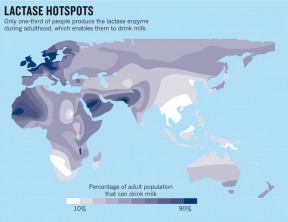The Historical Impact of Cattle on Human Behavior and Psychology
The question is not “How did cattle shape human cultural and psychological development?” but “How didn’t it?” I don’t believe an answer to this question exists; their influence and importance has been ubiquitous. For instance, in 1750 BCE, 29 of 282 Babylonian laws related to cattle and cattle ownership (Velton, 2007). In ancient Rome, it was punishable by death or exile to kill another’s cattle. For simplicity, I will focus attention on only a few areas of influence.
“Feeding tubes.” The use of aurochs and domestic cattle mark the beginning of an important trend in human behavior that is of ever-increasing relevance today. Few animals provide the breadth of resources the cow can provide. From meat, to leather, to milk, to dung, to horns (for jewelry and storage of liquid), to entertainment (e.g., Roman arenas), to draft power, cattle are the ideal animal to domesticate and have clearly been worth the effort required to tame a truly wild beast. To quote the PBS documentary Holy Cow, “The cow is perhaps the most useful animal there is” (Holy cow, 2004). This quotation is equally a statement about humans as it is about cattle. That is, the value attributed to objects by humans is largely a function of usefulness, of our ability to extract (or, less euphemistically, drain) from them, often in the absence of empathy and awareness of possible consequences. In my opinion, the domestication of cattle therefore represents the first instance of grandiose catering to our own needs and self-interest. Rather than exert energy into obtaining rouses from nature by seeking and hunting, cattle were the first “feeding tubes” we created for ourselves that automatically provided us with the majority of necessary resources. We see these feeding tubes today in the form of Amazon.com, food delivery services, and countless other entities.
Property and Capital. The word cattle comes from the Anglo-Norman word catel, which means “movable personal property,” and is closely related to capital. Cattle were likely the very objects around which humans formed value- and ownership-based cognitions, which were likely not present in the human psyche beyond the infantile “Mine!” behavior we observe in toddlers. In other words, prior to the domestication of cattle, it is unlikely that sophisticated forms of ownership and wealth existed. It follows that cattle were also the very first medium of exchange. In ancient Egypt, the number of cattle an individual owned was a measure of wealth used for taxation purposes (Velton, 2007). In the Maasai culture of Kenya and Tanzania today, when a man and woman marry, the woman’s family receives a cow in exchange for “delivering” their daughter to the man’s family (Holy cow, 2004). It would be interesting to explore how the use of cattle as currency evolved into other forms such as rare metals and coins.
Milk. As discussed in Rob Dunn’s The Wildlife of Our Bodies and other places (Dunn, 2011, Lactase persistence, n.d., Swaminathan, 2006), the advent of milk consumption by pre-domestic cultures is perhaps the most intriguing story behind the domestication of cattle.
Many in the U.S or in Northern European countries may not be aware that most of the world is lactose intolerant. Most animals are able to digest the sugar lactose (via the enzyme lactase) only in childhood while breastfeeding. However, approximately 35% of humans today are able to digest lactose through adulthood–a trait called lactase persistence.
What’s astonishing about lactase persistence is that roughly 10,000 years ago, prior to the domestication of goats and cattle, lactase persistence was essentially a nonexistent trait in humans. Over the course of a few thousand years, the trait has emerged and spread throughout several populations to the point that in, for instance, the Netherlands, 99% of the population is lactase persistent. By roughly 6000 BCE, a thriving dairy market was present in Northern Europe (Curry, 2013).

Darker areas exhibit higher prevalence of lactase persistence; lighter areas exhibit lower prevalence.
So what does the high prevalence of lactase persistence in some populations suggest? During certain periods of Northern European, East African, and Middle Eastern history–perhaps times of famine or other forms of struggle–owning cattle (or goats) or otherwise having a means to obtain milk may be been life-or-death. While the human diet requires nutrients not found in milk, a while there are other sources of nutrients found in milk, in periods of struggle, the protein, vitamins, minerals, and sugars it contains would have been indispensable. The importance of lactase persistence to some populations has been so high that biologist Sarah Tishkoff has called lactase persistence “the strongest signal of selection ever observed in any genome, in any study, in any population in the world” (Swaminathan, 2006). Considering that evolutionary biologists typically discuss population changes in terms of hundreds of thousands or millions of years, the fact that lactase persistence spread so overwhelmingly in a few thousand years is remarkable.